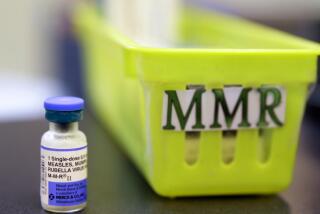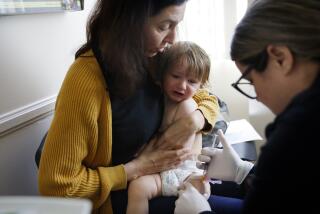Clinics Immunize Flood of Children Despite Budget Cut
SANTA ANA — As the shrieks of small children echoed into his office at the 17th Street clinic, Dr. Gerald A. Wagner didn’t so much as flinch.
As director of the county Health Care Agency’s vaccination programs for the past 26 years, the 54-year-old pediatrician is immune to the sound of terrified youngsters getting their back-to-school shots.
But the physician’s brow furrowed as he talked worriedly last week about this year’s budget cuts, especially cuts in the effort to immunize children against measles, polio, meningitis, and a host of other potentially deadly diseases.
A 4-year-old measles epidemic appears to be waning around the state but could easily flare up again, Wagner and other health officials warn. And though 300 children a day flood this clinic for back-to-school immunizations, this year’s resources to prevent childhood diseases are more limited than last year’s.
A $200,000 emergency state allotment to fight measles ran out in June, and there are no local or state funds to replace it.
Because the state funds were cut, special nighttime clinics that last year offered free childhood immunizations in Buena Park, Westminster and at the 17th Street clinic stopped in May and are not expected to resume this year.
Also gone with the state funds are twice-a-week immunization clinics at Santa Ana schools for measles and other childhood diseases. And, Wagner continued, in contrast with last year, the county probably won’t be able to dispatch an immunization team to schools if any new outbreaks occur.
Further, because of county budget cuts, 20 of 78 “well baby” clinics that for years have offered free immunizations to newborns and children up to age 6 are recommended for closure Oct. 1.
So Wagner is worried. “More children will go without shots,” he said glumly. “And we’re concerned about protection. Especially in the toddler group. Studies have shown at least 40% (of California’s preschoolers) are not immunized.” And unimmunized children set the stage for a new epidemic--perhaps measles again, perhaps whooping cough, perhaps some other deadly disease, Wagner warned.
Still, he promised, “we’ll do more with less.”
He and other health officials promise a full-court press to immunize children during the back-to-school rush that began Aug. 21, surged last week and is expected to peak right after Labor Day when many schools will start.
Certainly, county nurses were working hard last week as 250 to 355 children a day deluged the 17th Street clinic, waiting up to four hours for free immunizations in a line that wrapped along the south wall of the building and spilled into the parking lot.
Parents said they were determined to get the shots. They didn’t know much about a measles epidemic, some parents said, but they knew their children needed them to get into school.
Under state law, children must have immunizations against measles, mumps, rubella, polio and either diphtheria or diphtheria/tetanus for admission to kindergarten or preschool. Also by law, health professionals and young people in their first year of college are required to be immunized against measles. The set of vaccines, offered free at county clinics, can cost from $40 to $95 at a private physician’s office, health officials say.
Free shots or not, some parents grumbled as they stood for hours in line, some of that time directly in the midday sun.
“The lines are long,” said Martine Viridin, a 7-Eleven clerk from Garden Grove who had borrowed a friend’s car to take two children, ages 6 and 12, for their back-to-school-shots. But no matter the hassle, “we gotta have the shots.”
Amalia Cornejo, 25, of Santa Ana said she had to wait an hour Thursday morning for her son Sergio, a chubby 1-year-old, to get his shots. She knew he needed them “for his health.” And although she didn’t know much about measles or an epidemic, she did know that if he got the disease, “he could die.”
This week and through September, from five to seven nurses, two immunization specialists and two immunization clerks are expected to help to move the crowds into a waiting trailer or a clinic examining room for the shots.
Some nurses grumbled about a directive last week from clinics administrator Marty Earlabaugh asking that they inject 10 children an hour. Deriding that quota, one nurse complained, “We are not putting rivets into steel. These are children!”
But registered nurse Judy Devor said she interpreted the directive as a goal, not a quota. “We can try, can’t we?” she said. “It’s people that we’re spending time with here. We want them protected.”
Devor then turned back to her immunizations--this time to prepare an oral polio vaccine and three injections (one for measles/mumps/rubella, one for diphtheria and one for meningitis) for little Sergio.
As the little boy began to cry at the sight of the needles, Devor spoke to him gently. “I’m sorry, my sweetheart,” she said softly as she rapidly injected one dose of vaccine into the boy’s right arm, and two more shots in his left arm.
As the boy whimpered and snuggled into his mother’s lap, Devor handed a yellow immunization record book to a smiling Cornejo and continued talking to her baby. “All done. All done,” she said, comforting him. Another baby protected against possibly fatal disease.
More to Read
Sign up for Essential California
The most important California stories and recommendations in your inbox every morning.
You may occasionally receive promotional content from the Los Angeles Times.









